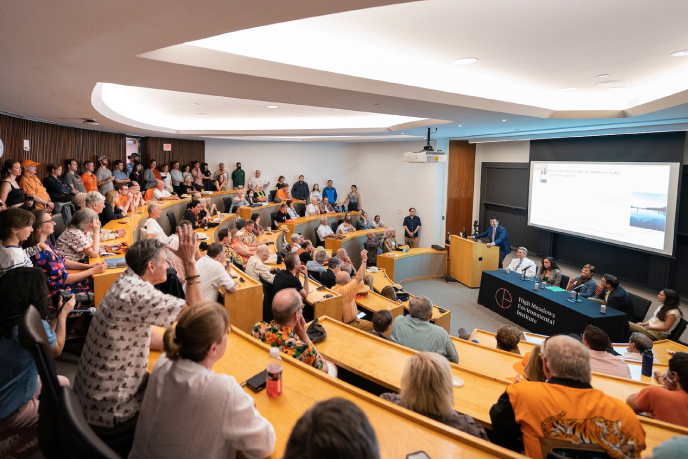Cooperative Institute for Climate Science News – Winter 2014
During the second half of 2013, some notable advances were made by Princeton University Cooperative Institute for Climate Science (CICS) researchers. Below is a highlight of recent research conducted by CICS Scientist Meiyun Lin.


Asian pollution drifts east toward North America in 2010. Hawaii is denoted by the star. (Source: Nature Geoscience)
Ozone near the Earth’s surface is a greenhouse gas and a health-damaging air pollutant, regulated by the U.S. Environmental Protection Agency (EPA). A new study led by Lin, who is also an associate research scholar in the Department of Atmospheric and Oceanic Sciences at Princeton, discovered that since the mid-1990s climate shifts have caused Asian ozone pollution reaching Hawaii to rise unexpectedly in autumn. The findings, published in Nature Geoscience, indicate that variability in airflow patterns must be considered when attributing observed ozone changes to human-induced trends in precursor emissions.


Researchers found that ozone levels measured during autumn at Mauna Loa Observatory in Hawaii (black line) accurately reflect the trend in rising Asian air pollution from 1975 to 2012. The researchers demonstrated that the autumnal rise in ozone could be explained by atmospheric and climatic shifts over periods of decades. Using a chemistry-climate model, the researchers modeled this autumnal variation in ozone using constant (red) and time-varying (purple) emissions of ozone precursors. (Source: Nature Geoscience)
The longest record of ozone measurements in the U.S. dates back to 1974 in Hawaii. Tropospheric ozone levels in the remote atmosphere have increased most in the spring due to powerful springtime winds and tripling emissions of ozone precursors from Asia over the past few decades. However, the 40-year Hawaiian record reveals little change in ozone levels during spring, but a sudden rise in autumn. Lin and her colleagues’ research has solved the puzzle. “We found that changing wind patterns “hide” the increase in Asian pollution reaching Hawaii in the spring, but amplify the change in the autumn,” said Lin.
Using chemistry-climate models and observations, Lin and her colleagues uncovered the different mechanisms driving spring versus autumn changes in atmospheric circulation patterns. The findings indicate that the flow of ozone-rich air from Eurasia towards Hawaii during spring weakened in the 2000s as a result of La-Niña-like decadal cooling in the equatorial Pacific Ocean. The stronger transport of Asian pollution to Hawaii during autumn since the mid-1990s corresponds to a positive pattern of atmospheric circulation variability known as the Pacific-North American pattern.
“This study not only solves the mystery of Hawaiian ozone changes since 1974, it also has broad implications for attribution of tropospheric ozone trends globally. Characterizing shifts in atmospheric circulation patterns is of paramount importance for understanding the response of tropospheric ozone levels to a changing climate and evolving global emissions of ozone precursors,” said Lin..
Meiyun Lin, Larry W. Horowitz, Samuel J. Oltmans, Arlene M. Fiore, Songmiao Fan. Tropospheric ozone trends at Mauna Loa Observatory tied to decadal climate variability. Nature Geoscience, Published Online: 26 January, 2014, http://dx.doi.org/10.1038/ngeo2066.



